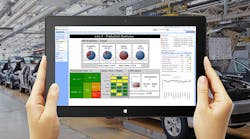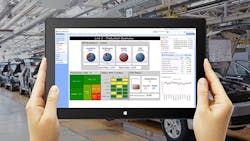Connectivity Helps Automakers Pick Up the Pace
With rapid economic growth in many developing countries and recovery of Western economies, automakers everywhere are pressured to build more vehicles using less materials, energy and resources. Average model lifespan between refreshes is down to 2.2 years, and a given model is being built in an average of six to eight plants around the world, leading to an environment of constant retooling and recommissioning.
"Manufacturing velocity is pressuring automakers and their suppliers to design, deploy and optimize more rapidly and efficiently than ever before," said Todd Montpas, market development manager, automotive & tire, Rockwell Automation, as he kicked off the Automotive & Tire Industry Forum today at the Automation Fair in Houston, presented by Rockwell Automation. Plants are expected to remain in production for 20 to 40 years, but must constantly adapt and improve their production and information systems, and are putting "a big focus on employee productivity," Montpas said.
Bringing the Connected Enterprise to the automotive industry is paving the path for information "from design to dealer," Montpas said, allowing automakers to bring real-time feedback from their products back to the plants. For example, a quality problem in the field can be quickly communicated and production corrected, "So you're not shipping a month or two months of vehicles with that problem," he said.
An MES for Every Need
Tier 1 suppliers' manufacturing execution system (MES) requirements have a lot in common, but they are also many and varied, according to Vaidee Sampathkumar,
director, automotive and discrete business, MESTECH Services, an IT solution provider focusing on the automotive and life science industries. From inventory control to quality, skills and tool management, satisfying those requirements starts with a template of the specific plant's functional requirements. Order management, materials and production tracking, quality management, finished products buffer and labor management are among the many options plants find worthwhile to include in their MES systems.
"We can see where a box is and its status anytime, anywhere in the plant." PEMSA's Jose Luis Diaz Ceballos on a new production management system for painting pickup truck boxes that has dropped processing time by two-thirds and improved overall efficiency by 70%.
Building a system starts by defining the production route, then adding part-mapping and detailed work instructions. "At each station, the operator gets a set of instructions of work to be done," Sampathkumar said. Controlled by bar coding as parts move from station to station, their work documentation moves with them from one screen to the next. "Operators get real-time monitoring and feedback, such as fastener torque; the screen displays when fastener torque has reached the correct level," Sampathkumar said.
The MES is integrated with the ERP system so the enterprise can be apprised of plant-floor results and can download the latest instructions to the MES. "Work instructions, error-proofing and quality management are easily configured and modified for new products," Sampathkumar said. If you want, you can include complete SPC functionality and operations intelligence, such as genealogy reports. "These are critical for products such as electric car batteries," he added.
Dashboards may include collaboration tools such as commenting, so managers can ask why a particular metric is not up to snuff. "People can write in all sorts of excuses and reasons for the problem, and if it should recur, they can review them to see what happened last time," Sampathkumar said.
One of the most powerful features of a good MES is knowledge management, including the details of how to do the work on the plant floor. "Operations don't have to be as highly trained or experienced if they're guided properly," Sampathkumar said.
Paint Booth Permutations
The PEMSA plant in Saltillo, Mexico, which supplies Chrysler with painted Ram pickup truck boxes, was challenged in 2013 to go from painting two versions of boxes in seven colors to more than 1,200 part numbers representing multiple versions of boxes in some 22 colors. The new level of complexity promised to overwhelm its already-taxed management and control systems, which used manual inventory and scheduling and rigid PLC controls with no visibility.
The plant installed a recipe-based production control system based on Rockwell Software FactoryTalk VantagePoint, with hooks to automated inventories and the SAP ERP system. "Now we can see when a box is received, when to paint it and when to deliver it," said Jose Luis Diaz Ceballos, maintenance manager at the PEMSA facility. "We can see where a box is and its status anytime, anywhere in the plant."
The system is designed to be administered, configured and modified by on-site personnel. "Sorry," Ceballos said, "Now we don't need our system integrators."
Time required to process a typical box has dropped from 24 to 9 hours. Direct communication with the customer, automated processing and collection of information have improved production efficiency 70%, and problems like robot crashes and unpainted boxes, each occasion of which used to shut down the line for 30 to 60 minutes, have vanished.
"That's why I can be here," said Ceballos. "My job is in maintenance."
More Flexible Assembly Cells
Similar needs for versatility and efficiency have led to development of the flexible assembly cell, according to Amir Shahnazary, engineering director, Comau, whose company specializes in automated production equipment for high-technology applications, including automotive and aerospace. Comau has been around for 40 years and is no small company, employing more than 13,000 and booking $2 billion in 2012.
The flexible assembly cell is inspired by business needs to align capacity with demand on the fly, reduce fixed and variable costs, and improve speed to market
—Amir Shahnazary, engineering director, Comau
"The flexible assembly cell is inspired by business needs to align capacity with demand on the fly, reduce fixed and variable costs, and improve speed to market," Shahnazary said. The traditional assembly line is linear. Parts are added as the assembly progresses through a succession of stations or tools. By doing an assembly line's work in one automated cell, the same work can be done in about half the footprint with about 60% fewer line components. Capacity can be adjusted by adding or removing cells. "It's parallel rather than serial processing," he said.
The same cell can make multiple kinds of assemblies by changing the tools and programming, which offers significant advantages over hard-tooled assembly lines in design-to-production time and cash flow. A conventional line requires 24 months from PO to production, and product design and capacity must be frozen early in the cycle. The equivalent time for a flexible cell is 19 months. Plus, designs can be changed much later, resulting in design freeze deadlines about 10 months later for a given target production start-up date.
Cash flow requirements also come much later and are initially much smaller for a cell system, where capacity can be added easily by simply duplicating the cell tooling. Eliminating many components and reducing floor space requirements also means "the total cost comes down a great deal," Shahnazary said.





